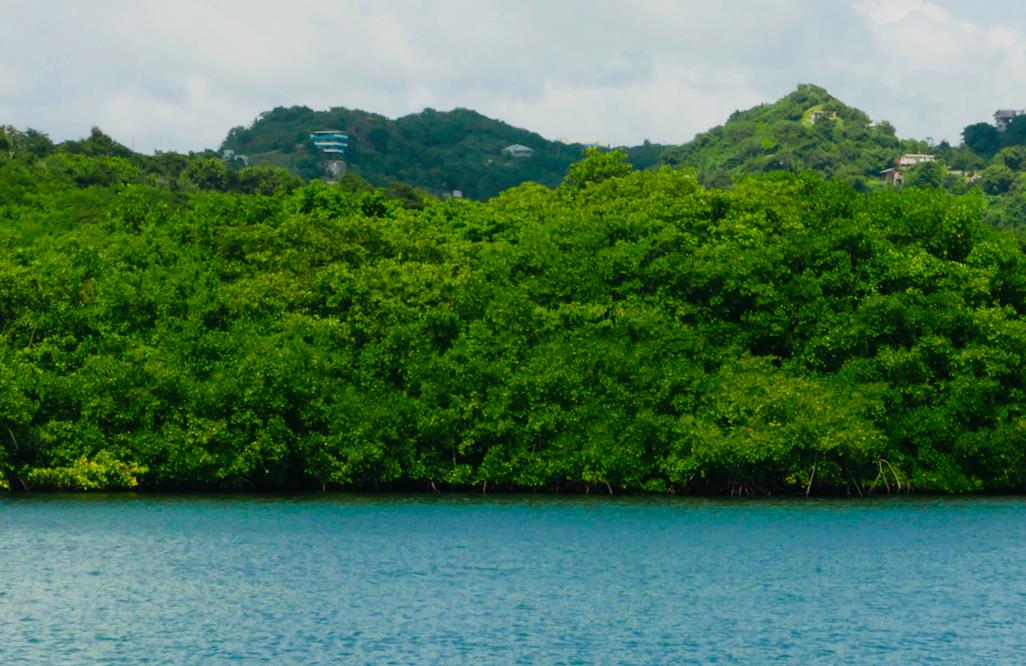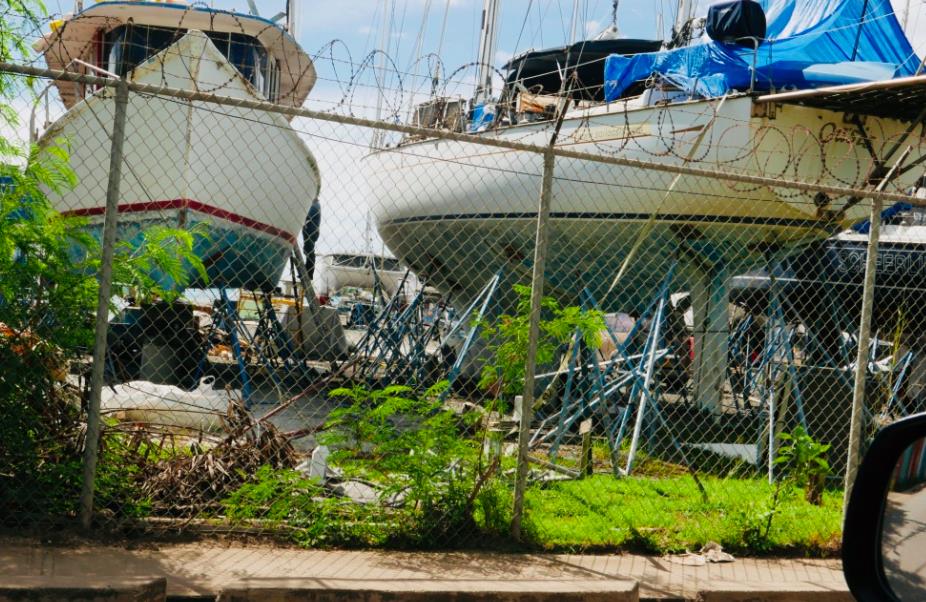
The Planning and Development Authority (PDA) has given planning consent for a boatyard for the storage and maintenance of 150 yachts to be built next to Secret Harbour. A number of local residents and environmentalists are expressing concern that another 5 acres of pristine Mt Hartman mangroves and dry scrub woodlands will soon be replaced by boats on stilts, vehicles, piles of materials and ugly chain link fencing and razor wire – and that the sea will become polluted.

Do we want it? Does Grenada need another boatyard enough to justify the inevitable destruction, disruption and pollution? Isn’t there a more industrial location? There are already boatyards with haul out facilities nearby in True Blue, Clarke’s Court and St David’s. Is business from a few yachties sufficient justification for another big hole in our “Pure Grenada” branding – already looking a bit thin – and our international environmental protection agreements? If we don’t want it is there anything that we can do about it now?
- We could apply to the court for leave for judicial review. This would argue that PDA has acted unlawfully, improperly or with procedural unfairness in giving consent – for example that the development violates planning or building laws, or that the Environmental Impact Assessment (EIA) is deficient or that its findings have not been taken into account properly or that PDA did not consult with those affected etc.
- We could accept that it is going to be built but try to ensure that all the environmental mitigation measures promised by the developers are actually put into practice during the construction and operation of the boatyard and that they are as effective as required. These constitute conditions under which consent has been granted and if they are not fulfilled the consent is not valid.
Either of these courses of action would be a headache for the developer and we must expect no Christmas cards from them!
Key issues
Some of the key issues with the proposal that have not been taken into account adequately and/or that give rise to mitigation measures that form conditions of the permission are summarised below. These are raised by:
- Planning and Development Authority/PPU (EIA Committee and Building Inspector)
- Chief Agricultural Officer
- Chief Environmental Health Officer
- Environmental Officer (Climate Resilience)
- Chief Forestry Officer
- Chief Fisheries Officer
- Engineer, Ministry of Infrastructure Development
- L’Anse aux Epines Association and other LAE residents.
Destruction of mangroves
Approximately 80 feet of mangrove will be removed permanently to allow access to the sea for the haul-out ramp and slipway. The adjacent larger section of mangroves is defined as “undisturbed” in the application/consent but in fact will almost certainly be disturbed by the construction of a section of the site with boulders wrapped in Geotextile fabric down to the sea. Destruction of the native mangroves is now a very important issue in Grenada. They protect the coastline including reducing the effects of storm surges, filter the water and provide nursery conditions for much marine life including fish caught and consumed locally.
The consent requires:
- the presentation of a plan for the removal, storage and replanting of the mangrove
- removal only as necessary
- the developer to support replanting in conjunction with the relevant ministry.
Chemical and biological contamination
Engine and boat maintenance, power washing and cleaning, wet sanding, painting etc. risk the run-off of chemicals and contamination of soil, ground water and sea building up over time. Antifouling is toxic to aquatic life. Most antifouls are now copper or zinc based and some of the compounds found in these antifouls can accumulate in marine organisms, and can find their way into marine wildlife further up the food chain. The majority of copper in antifouling enters the marine environment through leaching. However concentrated amounts do enter the marine environment during the removal of antifouling paint, which occurs mostly by water blasting or mechanical scraping and sanding and can form concentrated deposits in the sediments around boatyards and marinas.
With the absence of sea currents to clear out this dead-end of the bay, chemical or biological contamination will threaten the existence of marine life and could result in green algae growth in the closed end of the bay affecting residents and the Secret Harbour marina.
The consent requires:
- construction of a dedicated concrete boat wash pad with a collection trough and sump
- collection and transfer of the wash water to a closed loop re-cycling unit
- capture of heavy solids in a settling tank
- capture of finer materials including trace metals and oils in filters
- recycling of the effluent for use in the wash equipment
- a wastewater treatment plant to treat all other effluent including sewage and its use for irrigation
- achievement of Blue Flag Marina accreditation to ensure adequate standards of environmental management including water quality and chemicals used (eg. no lead-based paints).
This implies that stored boats will have to be moved to the wash pad for work one by one and it is not clear how this can be done in practice. The location of the wash pad is not clear and was not shown on the original plans. How effectively will these mitigation measures be achieved and who will ensure that that are effective? It is not clear what irrigation treated effluent would be used for since there is no landscaping to irrigate. There is no boatyard or marina in the Eastern Caribbean that has Blue Flag accreditation.
Drainage and silting of the seawater
Dredging is required to achieve the depths of water to allow boats to reach the haul out and slipway. Landfill works will be extensive and up to the waters edge. The boat haul out slope tracks will be piled into the seabed. The site will no longer have natural vegetation to slow and absorb rainwater run-off, which will be collected in a series of concrete box drains and discharged to the sea. All of these will cause silting and increased turbidity in Mt Hartman Bay adversely affecting marine life, residents and Secret Harbour marina.
The consent requires:
- installation of a silt net during construction to stop disturbed silt from entering the bay
- installation of silt traps on the surface drainage system to prevent silt run-off reaching the sea
- rainwater collection from buildings to reduce run-off (and reduce mains water consumption, already a problem in this area).
Floating jetty
Is there to be a floating jetty or not? The EIA did not include this or evaluate its environmental effects during construction or boatyard operations. It says that although one is shown on Fig 2.5 of the EIA this has been removed from the development plans. The application form does not include a floating jetty or marina. The developer states that the project is a boatyard and will not offer marina amenities – and this can now be construed as a condition for the planning consent. So we maintain that any plans for a floating jetty must be subject to a new planning application.
Other considerations
These are by no means the only risks and disbenefits of the project. Boatyards are not pretty places and chain link fencing and razor wire is no competition for the green mangroves and trees that now cover the site and are enjoyed by residents and visitors. With the big Mt Harman developments on hold and under judicial review in the courts, the destruction of mangroves here is the thin end of the wedge – any future application can cite this precedent.
Boatyards are not quiet places during both construction and operation. This will change the character of this corner of the bay to the disbenefit of residents and Secret Harbour.
The developer is called Grenada Green Boatyard & Marine Services Ltd. (note the “green”!). They have been asked for a meeting but so far have not responded.
So, realistically, could we ever ensure that these mitigation measures were put in place? PDA does not have the capacity to do this even if it wanted to so we, the community, would have to do it and press PDA and relevant ministries to act on specific conditions. The relevant legislation is clear that “any development of land shall be carried out in accordance with the permission granted by the Authority, the approved plan and subject to any conditions” and that failure to do so is a serious offence and can be subject to imprisonment. The development can be issued with enforcement and stop notices and, if deemed expedient by the Minister, permission may be revoked.
There are lessons here in how planning and development control should not be done. These include EIAs being done for the developer rather than the country and therefore predisposed towards development, the lack of electronic access to applications by the public so that they can object in time, the absence of any communication by PDA to neighbours and interested parties, granting of consents with conditions that will require extensive monitoring by PDA when it has no capacity to do this etc. We discussed some of them earlier: http://www.coralcovegrenada.org/2022/07/18/an-open-letter-to-our-new-government-about-things-that-concern-us-as-the-coral-cove-group/
It seems to us at Coral Cove Group that times have changed! More and more people are understanding that despoliation of our natural environment is unacceptable and not in Grenada’s best interests. But our planning system is behind the curve and it’s for us to press for change and oppose developments we don’t want and that are not good for Grenada. The only way to stop it now is judicial review for which we will have to organise a fund raiser for legal fees.
What do you want to do? Tell us!
Coral Cove Group
